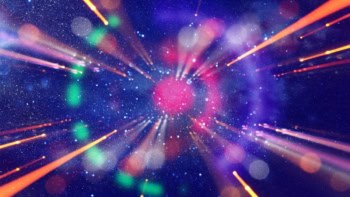An international team of physicists working at the Relativistic Heavy Ion Collider (RHIC) at the Brookhaven National Laboratory in the US says it has found strong evidence for the "quark-gluon plasma" -- the state of matter thought to exist in the first millionth of a second after the Big Bang. However, the researchers found that instead of behaving like a gas of free quarks, antiquarks and gluons as expected, the matter behaves more like a liquid. The results were presented at the April meeting of the American Physical Society yesterday
A quark-gluon plasma (QGP) is believed to have existed before the universe cooled and free quarks and gluons combined into protons and neutrons, which then bound together to form light nuclei. Physicists at the CERN laboratory in Geneva claimed to have created a QGP in 2000 but the results were inconclusive because the plasma existed only fleetingly. Then in 2003, RHIC scientists said they had come closer than ever before to creating a QGP.
RHIC uses accelerators to increase the energies of gold atoms up to 100 billion electron volts inside a 4-kilometre ring and then collides them together. When a gold nucleus collides with another gold nucleus the constituent protons and neutrons are thought to melt together to form a QGP.
The new results indicate that some of the observations at RHIC agree with theoretical predictions for a QGP. But many theoretical physicists believe that the QGP should be a gas, whereas the matter formed at RHIC appears to behave more like an almost “perfect” liquid.
The new matter created at RHIC could in fact be a form of the QGP but just different from what has been theorized says Sam Aronson, a Brookhaven director. More detailed measurements are now underway at RHIC to resolve this question.
According to Ulrich Heinz, a theoretical physicist at Ohio State University in Columbus, the prediction that the QGP is a gas is not based on solid theory but is more a qualitative statement based on “folklore” that few physicists have really challenged. “I think this is the most important nuclear physics result in recent years and have been saying for the last two years that RHIC has produced a QGP,” he told PhysicsWeb. “That the QGP is an almost ideal liquid instead is extremely interesting — and definitely not expected by everyone — but it is in no way inconsistent with previous theoretical calculations.”
Johann Rafelski, a nuclear physicist at Arizona University in the US, agrees. “The RHIC experiment has much improved since the last results were published in 2003. Furthermore, the signatures are much clearer and not in conflict with earlier results at RHIC and CERN,” he says.
The teams will publish their results in the journal Nuclear Physics A, and in a special 350-page Brookhaven report.



